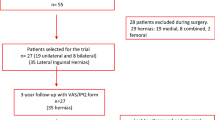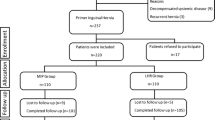Abstract
Background and aims
Polypropylene mesh repair of large incisional ventral hernias has become increasingly popular. Long-term effects of the mesh on pain and abdominal muscles are not known.
Patients/methods
Retromuscular pre-peritoneal polypropylene mesh was placed by open technique in 84 consecutive patients with large ventral hernias (mean defect size 130 cm2). We re-examined the patients after a mean follow-up time of 3 years to find out the frequency of recurrence and chronic pain. We measured the thickness of abdominal muscles of eight patients preoperatively, and postoperatively after 1 year, using magnetic resonance imaging (MRI).
Results
Recurrent hernias had appeared in four patients (5%) at follow-up. Nine patients (13%) needed occasional pain-relieving drugs, but only three (4%) suffered persistent, severe, pain from the mesh. Some limitation during leisure-time physical activities was found in 10% of patients. Only ten patients (12%) were re-operated on because of wound complications or recurrence. MRI study indicated that abdominal muscles were postoperatively well preserved. Although wound infections (6%) and seroma (9%) were frequent complications, there was no need for meshes to be removed in the follow-up.
Conclusion
Open ventral herniorrhaphy with mesh is safe, effective and inexpensive. Small, recurrent hernias were infrequent and easy to re-operated on. Severe pain from the mesh was not common. Postoperative MRI study indicated no obvious damage of abdominal muscles after mesh placement.

Similar content being viewed by others
References
Cassar K, Munro A (2002) Surgical treatment of incisional hernia. Br J Surg 89:534–545
Sukkar SM, Dumanian GA, Szczerba SM, Tellez MG (2001) Challenging abdominal wall defects. Am J Surg 181:115–121
Ramirez OM, Ruas E, Dellon L (1990) “Components separation” method for closure of abdominal wall defects: an anatomic and clinical study. Plast Reconstr Surg 86:519–526
Luijendijk RW, Hop WCJ, van den Tol MP (2000) A comparison of suture repair with mesh repair for incisional hernia. N Eng J Med 343:392–398
Mathes SJ, Steinwald PM, Foster RD, Hoffman WY, Anthony JP (2000) Complex abdominal wall reconstruction: a comparison of flap and mesh closure. Ann Surg 232:586–596
Rives J, Pire JC, Flament JB (1985) Treatment of large eventrations. New therapeutic indications apropos of 322 cases. Chirurgie 111:215–225
Stoppa RE (1989) The treatment of complicated groin and incisional hernias. World J Surg 13:545–554
Heniford BT, Park A, Ramshaw BJ, Voeller G (2000) Laparoscopic ventral and incisional hernia repair in 407 patients. J Am Coll Surg 190:645–650
Ramshaw BJ, Esartia P, Schwab J (1999) Comparison of laparoscopic and open ventral herniorrhaphy. Am Surg 65:827–832
Bay-Nielsen M, Perkins FM, Kehlet H (2001) Pain and functional impairment 1 year after inguinal herniorrhaphy: a nationwide questionnaire study. Ann Surg 233:1–7
Poobalan AS, Bruce J, Smith WC, King PM, Krukowski ZH, Chambers WA (2003) A review of chronic pain after inguinal herniorrhaphy. Clin J Pain 19:48–54
Martin-Duce A, Noquerales F, Villeta R, Hernandez P (2001) Modifications to Rives technique for midline incisional hernia repair. Hernia 5:70–72
Wantz GE (1991) Incisional hernioplasty with Mersilene. Surg Gynecol Obstet 172:129–137
Toms AP, Dixon AK, Murphy JM, Jamieson NV (1999) Illustrated review of new imaging techniques in the diagnosis of abdominal wall hernias. Br J Surg 86:1243–1249
Petersen S, Henke G, Freitag M, Faulhaber A, Ludwig K (2001) Deep prosthesis infection in incisional hernia repair: predictive factors and clinical outcome. Eur J Surg 167:453–457
Temudom T, Siadati M, Sarr MG (1996) Repair of complex giant or recurrent ventral hernias by using tension-free intraparietal prosthetic mesh (Stoppa technique): lessons learned from our initial experience (fifty patients). Surgery 120:738–743
McLanahan D, King LT, Weems C, Novotney M, Gibson K (1997) Retrorectus prosthesis mesh repair of midline abdominal hernia. Am J Surg 173:445–449
Maas SM, Reilingh TSV, Goor H, de Jong D, Bleichrodt RP (2002) Endoscopically assisted “components separation technique” for the repair of complicated ventral hernias. Am Coll Surg 194:388–340
Paajanen H (2002) Do absorbable mesh sutures cause less chronic pain than nonabsorbable sutures after Lichtenstein inguinal herniorrhaphy? Hernia 6:26–28
Author information
Authors and Affiliations
Corresponding author
Rights and permissions
About this article
Cite this article
Paajanen, H., Hermunen, H. Long-term pain and recurrence after repair of ventral incisional hernias by open mesh: clinical and MRI study. Langenbecks Arch Surg 389, 366–370 (2004). https://doi.org/10.1007/s00423-003-0440-0
Received:
Accepted:
Published:
Issue Date:
DOI: https://doi.org/10.1007/s00423-003-0440-0




